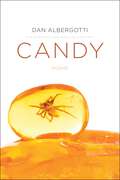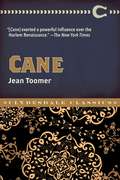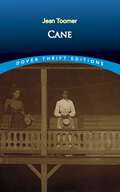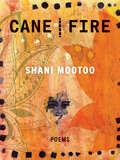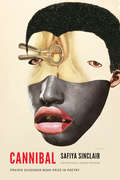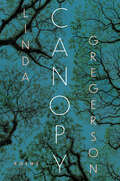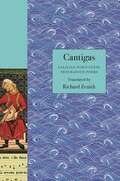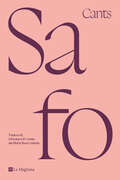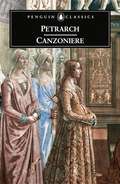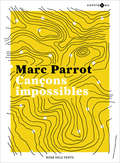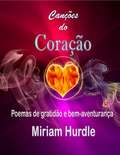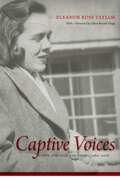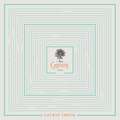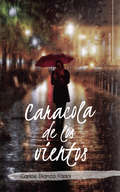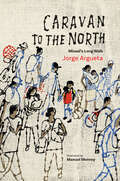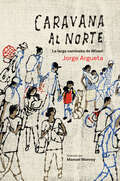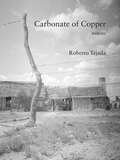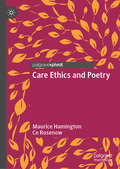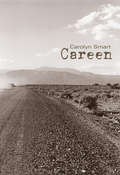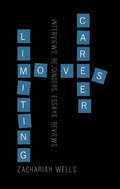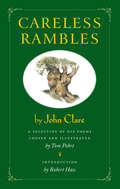- Table View
- List View
Candy: Poems (Sewanee Poetry)
by Dan AlbergottiDan Albergotti’s Candy is a book steeped in sound and silence. Sound in the form of song, of chaotic cacophony, and of the drone (sometimes natural, sometimes manufactured) that creates the ambient soundtrack of history and the seemingly apocalyptic present. Silence in the sense both of the void’s innate quietude and of the failure to speak—of people either dumbstruck or in denial, not speaking because they cannot or will not. Throughout this collection, these sounds and intermittent silences provide the rhythm for poems that question the nature of truth and myth, and that restlessly search for meaning in a reticent universe, ultimately unwilling to take no for an answer as they strive to find an ever-elusive yes.
Cane (Clydesdale Classics #0)
by Jean Toomer&“Cane . . . exerted a powerful influence over the Harlem Renaissance&”—The New York TimesCane is a collection of short stories, poems, and dramas, written by Harlem Renaissance author Jean Toomer in 1923. The stories focus around African-American culture in both the North and the South during times when racism and Jim Crow laws still abounded. Vignettes of the lives of various African-American characters tell what it was like to live both in the rural areas of Georgia and the urban streets of the northern cities. The book was heralded as an influential part of the Harlem Renaissance and, at the time, influenced artists of every background. Authors, dramatists, and even jazz musicians could find influence and inspiration in the pages of Cane&’s work. Both Zora Neale Hurston and Langston Hughes themselves visited Sparta, Georgia, after reading Toomer&’s work. Unfortunately, the white public did not react well to Cane, and the sales dropped. The book did not become revered as the classic work it is today until the Civil Rights Movement in the 1960s. Now you can read this new edition of what is considered one of the best works of the Harlem Renaissance.
Cane (Dover Thrift Editions #0)
by Jean Toomer"[Cane] has been reverberating in me to an astonishing degree. I love it passionately; could not possibly exit without it." — Alice Walker "A breakthrough in prose and poetical writing …. This book should be on all readers' and writers' desks and in their minds." — Maya Angelou Hailed by critics for its literary experimentation and vivid portrayal of African-American characters and culture, Cane represents one of the earliest expressions of the Harlem Renaissance. Combining poetry, drama, and storytelling, it contrasts life in an African-American community in the rural South with that of the urban North. Author Jean Toomer (1894–1967) drew upon his experiences as a teacher in rural Georgia to create a variety of Southern psychological realism that ranks alongside the best works of William Faulkner. The book's three-part structure, ranging from South to North and back again, is united by its focus on the lives of African-American men and women in a world of bigotry, violence, passion, and tenderness.
Cane Fire
by Shani MootooFrom internationally celebrated writer and visual artist Shani Mootoo comes Cane | Fire, an immersive and vivid collection that marks a long-awaited return to poetry.Throughout this evocative, sensual collection, akin to a poetic memoir, past and present are in conversation with each other as the narrator moves from Ireland to San Fernando, and finally to Canada. The reinterpretations and translation of this journey and its associated family history give meaning to the present. Through these deeply personal poems, and Mootoo's own artwork, we begin to understand how a life can not only be shaped, but even reimagined.
Cannibal (Prairie Schooner Book Prize in Poetry)
by Safiya SinclairColliding with and confronting The Tempest and postcolonial identity, the poems in Safiya Sinclair’s Cannibal explore Jamaican childhood and history, race relations in America, womanhood, otherness, and exile. She evokes a home no longer accessible and a body at times uninhabitable, often mirrored by a hybrid Eve/Caliban figure. Blooming with intense lyricism and fertile imagery, these full-blooded poems are elegant, mythic, and intricately woven. Here the female body is a dark landscape; the female body is cannibal. Sinclair shocks and delights her readers with her willingness to disorient and provoke, creating a multitextured collage of beautiful and explosive poems.
Canopy: Poems
by Linda GregersonA long-awaited yet startlingly urgent new collection from &“a contemporary master&”*—a fierce, big-hearted eye on our last, tumultuous decade, and our fragile environment *Los Angeles Review of Books Linda Gregerson&’s long-awaited new collection is a tour de force, a compendium of lives touched by the radical fragility of the planet and, ultimately, the endless astonishment and paradox of being human within the larger ecosystem, &“in a world where every breath I take is luck.&” From the Syrian refugee and ecological crises, to police brutality and COVID, to the Global Seed Vault buried under permafrost, the poems ask: How does consciousness relate to the individual body, the individual to the communal, the community to our environment? How do we mourn a loved one, and how do we mourn strangers? The magnificent poems in Canopy catalogue and reckon with humanity and the natural world, mortality, rage, love, grief, and survival.
Cantigas: Galician-Portuguese Troubadour Poems (The Lockert Library of Poetry in Translation #140)
by Richard ZenithA bilingual volume that reveals an intriguing world of courtly love and satire in medieval Portugal and SpainThe rich tradition of troubadour poetry in western Iberia had all but vanished from history until the discovery of several ancient cancioneiros, or songbooks, in the nineteenth century. These compendiums revealed close to 1,700 songs, or cantigas, composed by around 150 troubadours from Galicia, Portugal, and Castile in the thirteenth and early fourteenth centuries. In Cantigas, award-winning translator Richard Zenith presents a delightful selection of 124 of these poems in English versions that preserve the musical quality of the originals, which are featured on facing pages. By turns romantic, spiritual, ironic, misogynist, and feminist, these lyrics paint a vibrant picture of their time and place, surprising us with attitudes and behaviors that are both alien and familiar.The book includes the three major kinds of cantigas. While cantigas de amor (love poems in the voice of men) were largely inspired by the troubadour poetry of southern France, cantigas de amigo (love poems voiced by women) derived from a unique native oral tradition in which the narrator pines after her beloved, sings his praises, or mocks him. In turn, cantigas de escárnio are satiric, and sometimes outrageously obscene, lyrics whose targets include aristocrats, corrupt clergy, promiscuous women, and homosexuals.Complete with an illuminating introduction on the history of the cantigas, their poetic characteristics, and the men who composed and performed them, this engaging volume is filled with exuberant and unexpected poems.
Canto del Desencanto
by Mongiardim SaraivaCanto es amor, exaltación, libertad. El desencanto es todo aquello que niega ese sueno deja un rasto de tristeza y descontento. El canto del Desencanto quiere transformar esa angustiay soledad, a través de la poesía. En algo apacible, estético y quizás incluso interesante.
Cantos de vida y esperanza
by Rubén DaríoLos mejores libros jamás escritos Edición de Rocío Oviedo Pérez de Tudela, catedrática de literatura hispanoamericana en la Universidad Complutense de Madrid Para muchos, Rubén Darío es el padre del modernismo. Los poetas parnasianos y simbolistas franceses ejercieron una gran influencia en su obra, pero a partir de Prosas profanas (1896 y 1901) su estilo, perfilado en Azul (1888, revisado en 1890 y celebrado como el primer poemario modernista), se define para llegar a Cantos de vida y esperanza (1905), considerado el mejor ejemplo de su poesía. Aquí el poeta vuelve a sus temas recurrentes para afirmar que el arte siempre superará a la naturaleza, pues es el único elemento capaz de restablecer la armonía divina. Esta edición incluye una introducción que contextualiza la obra, un aparato de notas, una cronología y una bibliografía esencial, así como también varias propuestas de discusión y debate en torno a la lectura. Está al cuidado de Rocío Oviedo Pérez de Tudela, catedrática de literatura hispanoamericana de la Universidad Complutense. «Y parece que el hondo mirar cosas dijera, especiosas y ungidas de miel y de veneno.»
Cantos de vida y esperanza (Los mejores clásicos #Volumen)
by Rubén DaríoLos mejores libros jamás escritos Edición de Rocío Oviedo Pérez de Tudela, catedrática de literatura hispanoamericana en la Universidad Complutense de Madrid Para muchos, Rubén Darío es el padre del modernismo. Los poetas parnasianos y simbolistas franceses ejercieron una gran influencia en su obra, pero a partir de Prosas profanas (1896 y 1901) su estilo, perfilado en Azul (1888, revisado en 1890 y celebrado como el primer poemario modernista), se define para llegar a Cantos de vida y esperanza (1905), considerado el mejor ejemplo de su poesía. Aquí el poeta vuelve a sus temas recurrentes para afirmar que el arte siempre superará a la naturaleza, pues es el único elemento capaz de restablecer la armonía divina. Esta edición incluye una introducción que contextualiza la obra, un aparato de notas, una cronología y una bibliografía esencial, así como también varias propuestas de discusión y debate en torno a la lectura. Está al cuidado de Rocío Oviedo Pérez de Tudela, catedrática de literatura hispanoamericana de la Universidad Complutense. «Y parece que el hondo mirar cosas dijera, especiosas y ungidas de miel y de veneno.»
Cants
by SafoCants de Safo és una obra precursora i representa un model per a les escriptores que la van seguir, en tant que l'autora hi crea un llenguatge nou per expressar l'amor. El nom de la primera poeta de la lírica occidental ens arriba envoltat de misteri. Un misteri que totes les èpoques han volgut desvetllar atribuint-li biografies més o menys fantasioses en una recreació contínua de la seva imatge. Però per damunt de les especulacions sobre la seva vida privada, ens resten els fragments d'una conscient i elaborada art poètica, singularment expressiva dins d'unaaparent senzillesa i creadora d'un llenguatge nou per expressar l'amor. Precursora i model d'escriptores, tant antigues com modernes, Safo ens presenta un món fet a la mesura de la dona, però d'una dona que parla i vol, que deixa sentir la seva veu a través del cant i de la creació poètica.
Canzoniere
by PetrarchThe 'Canzoniere', a sequence of sonnets and other verse forms, were written over a period of about 40 years. They describe Petrarch's intense love for Laura, whom he first met in Avignon in 1327, and her effect on him after she died in 1348. The collection is an examination of the poet's growing spiritual crisis, and also explores important contemporary issues such as the role of the papacy and religion.
Cançons impossibles
by Marc ParrotEl cantant i compositor Marc Parrot, ens endinsa en el seu mon particular gràcies als seus poemes. Il·lustrat per Ohiane Inchaustegui M'he dedicat a compondre cançons des d'abans de ser qui havia de ser. Ho he fet sempre com una necessitat que em porta a resoldre no sé ben bé què, com tampoc sé del cert d'on sorgeix. Potser és només que explicar-me representaria una petita conquesta de mi mateix: fer-me meu a còpia d'aquests intents juganers, més o menys encertats. L'objectiu inconscient es va revelant com una mena de premi: la consciència per gaudir més del que ja sé i que em fa veure el que desconec com quelcom més interessant. I ja estic preparat per llançar tot el que he escrit al foc.
Canções do coração: Poemas de gratidão e bem-aventurança
by Miriam HurdleCanções do coração toca a melancólica melodia do sofrimento e transcende a melodia da serenidade e da paz. É um caminho percorrido com otimismo, esperança e apreço em meio a situações de dor no coração e um câncer imprevisível. Ele também celebra o amor verdadeiro e a realização dos relacionamentos.. Hurdle em sua coleção de poesia inclui nove temas: Canções da Natureza, Canções de Dissonância, Canções de Cura Física, Canções de Casamento, Canções de Paternidade, Canções de Tributo, Canções de Reflexões, Canções de Desafio e Canções de Inspiração. Cada um desses temas abrange vários aspectos de sua experiência de vida. Muitos poemas são ilustrados com suas fotos e pinturas em aquarela. Os poemas desta coleção são inspiradores para a mente, coração e espírito. Os leitores ecoarão com essas experiências.
Captive Voices: New and Selected Poems, 1960-2008 (Southern Messenger Poets)
by Ellen Bryant Voigt Eleanor Ross TaylorOver nearly fifty years, Eleanor Ross Taylor has established herself as one of the foremost southern poets of her generation. Captive Voices gathers selections from Taylor's five previous books along with a generous helping of new poems. Scintillating, unusual, passionate, and profound, the poems range from contemporary pieces about a bag lady on a bus, to historical pieces about settlers held hostage and a wartime nurse caring for British wounded, to intensely personal poems about her dislike for her grandmother and worries about her son. The title poem -- a real tour de force -- explores the notion of captivity on several levels as it speaks to the suffering we all endure, some of which is of our own making. Decidedly regional yet determinedly universal, the poems in this remarkable volume, along with a foreword by Ellen Bryant Voigt, attest to the singular talent of a woman justly described as "a poet of genius."
Captivity: Poems
by Laurie SheckThe "exquisite and haunting" (Booklist) collection of poems built around the language and mystique of American captivity narratives in which Sheck enters the vivid life we live inside our own minds and selves, and takes us into the mysterious underside of consciousness and selfhood.From the Trade Paperback edition.
Caracola de los vientos
by Carlos Blanco FadolUna sutil ofrenda a la mujer, especialmente a aquellas que alumbraron mi camino de sendas entrecruzadas. Caracola de los vientos es un poemario centrado en la mujer, en ese amor de mujer que el autor guarda como camafeo en las soledades de los caminos, y constituye el incentivo principal de su viaje, en esa búsqueda ancestral que no tiene bien definida, pero que compensa ir por la vida intentando encontrarla.
Caravan to the North: Misael’s Long Walk
by Jorge ArguetaAn urgent and eloquent account of a boy traveling in a caravan from his beloved homeland of El Salvador to the US border. This novel in verse is a powerful first-person account of Misael Martínez, a Salvadoran boy whose family joins the caravan heading north to the United States. We learn all the different reasons why people feel the need to leave — the hope that lies behind their decision, but also the terrible sadness of leaving home. We learn about how far and hard the trip is, but also about the kindness of those along the way. Finally, once the caravan arrives in Tijuana, Misael and those around him are relieved. They think they have arrived at the goal of the trip — to enter the United States. But then tear gas, hateful demonstrations, force and fear descend on these vulnerable people. The border is closed. The book ends with Misael dreaming of El Salvador. This beautiful and timely story is written in simple but poetic verse by Jorge Argueta, the award-winning author of Somos como las nubes / We Are Like the Clouds. Award-winning Mexican illustrator Manuel Monroy illuminates Misael’s journey. An author’s note is included, along with a map showing the caravan’s route. Key Text Features author’s note map illustrations Correlates to the Common Core State Standards in English Language Arts: CCSS.ELA-LITERACY.RL.4.3 Describe in depth a character, setting, or event in a story or drama, drawing on specific details in the text (e.g., a character's thoughts, words, or actions).
Caravana al Norte: La larga caminata de Misael
by Jorge ArguetaEste hermoso y poético relato de un niño que viaja en una caravana desde El Salvador hacia la frontera de los Estados Unidos, ofrece una necesaria y elocuente visión que contrarresta las mentiras que se escuchan acerca de los inmigrantes centroamericanos cuya única opción es abandonar sus amadas tierras natales.Esta novela en verso es un poderoso relato en primera persona. Cuenta la historia de Misael Martínez, un niño salvadoreño cuya familia se une a la caravana que viaja al Norte, hacia los Estados Unidos. Nos muestra muchas de las razones que hacen que personas sientan la necesidad de irse, la esperanza que se esconde detrás de esta decisión, y la terrible tristeza de abandonar sus hogares. Es un aprendizaje sobre lo largo y arduo del viaje pero también sobre la bondad de aquellos que los ayudan a lo largo del camino. Cuando la caravana finalmente llega a Tijuana, Misael y los que lo acompañan se sienten aliviados. Piensan que han alcanzado la meta del viaje de entrar a los Estados Unidos. Pero enseguida el gas lacrimógeno, las protestas cargadas de odio, la fuerza bruta y el miedo caen sobre esta gente tan vulnerable. La frontera sigue cerrada. El libro termina con Misael soñando con El Salvador.Esta hermosa y relevante historia está escrita en el verso accesible y poético de Jorge Argueta, el galardonado autor de Somos como las nubes / We are Like the Clouds. El premiado ilustrador mexicano Manuel Monroy ilumina la travesía de Misael. El libro incluye una nota final del autor y un mapa que ilustra la ruta de la caravana. Key Text Featuresauthor’s notemapillustrations
Carbonate of Copper
by Roberto TejadaBringing together lyric poetry, documentary photographs, and lives lived along the U.S.-Mexico borderlandWritten during extended periods in Brownsville, McAllen, and Marfa, Texas, in Carbonate of Copper Roberto Tejada gives voice to unsettled stories from the past, as well as to present-day experiences of custody and displacement. The poems stage scenes adjacent to the U.S.-Mexico border and to the realities of migration warped by jarring political vitriol, bearing witness to past and present-day hazards and sorrows wagered by those in search of asylum. So enabled, these poems make visible not only the infrastructure of militarized surveillance and its detention complex but also the aspiration to justice and mercy and the resilient self-organized order of time for migrants seeking human dignity while awaiting passage to the other side of the dividing line.The book’s title refers also to a mineral found in azurite and malachite, a color medium that had an impact on art during the first phase of globalization, the ensuing colonial enterprise, and its systems of extraction. Carbonate of copper was less desirable than the deeper ultramarine made from ground lapis lazuli, but Renaissance artists and patrons nonetheless coveted it and prompted a market for the blue derivative used in tempera and oil pigment. The blue powder pigment serves, too, as a form of sorcery: one that would ward off those who deal in injury of the already dispossessed.Turning his attention to the forced relocation of peoples, the COVID-19 death toll, the encroaching dangers of illiberal rule, the meanings of home and eviction, the power of cultural memory, as well as his artistic forebears, Tejada accounts for the uncounted and those excluded from belonging in voices that tell the cruel fortunes and joyful vitality of human and non-human life forms.
Cardinal in the Eastern White Cedar
by Roo BorsonA captivating and poignant new collection of poetry from Griffin Poetry Prize winner Roo Borson that probes some of our most important questions.After Roo Borson's two previous collections -- Short Journey Upriver Toward Oishida and Rain; road; an open boat -- set the seasons in motion, focusing the poet's mind on time, mortality, transience, and absence, Cardinal in the Eastern White Cedar arrives to complete the triptych. From the glittering, classically rendered image to a freighted, lucid, narrative line, Borson's voice can shift and refract while holding true to the momentary facts of the shifting, given world. Her meditations are a kind of fidelity to inquiry, to attachment, to what can't be fully known. Here the distant past collides with the near future, the present opens suddenly into another age, and friendship becomes the measure of time's salience. These poems depict what vanishes, the various modest homes where half-remembered lives all flow toward their common end. Roo Borson has crowned a sustained achievement with a work of startling intimacy and vividness.
Care Ethics and Poetry
by Maurice Hamington Ce RosenowCare Ethics and Poetry is the first book to address the relationship between poetry and feminist care ethics. The authors argue that morality, and more specifically, moral progress, is a product of inquiry, imagination, and confronting new experiences. Engaging poetry, therefore, can contribute to the habits necessary for a robust moral life—specifically, caring. Each chapter offers poems that can provoke considerations of moral relations without explicitly moralizing. The book contributes to valorizing poetry and aesthetic experience as much as it does to reassessing how we think about care ethics.
Careen
by Carolyn SmartBonnie Parker and Clyde Barrow are the stuff of legend -- why tell their story again? Chances are you don’t know the nuances -- their love story and that of their accomplices Buck Barrow and his wife Blanche; their aspirations, conflicts and prayerful natures; and ultimately the sources of their tragedy. At its core, Careen is a long poem spoken by the characters, though the voices are companioned by newspaper articles often ironically at odds with the inside story. Smart lets the principal actors relate their own tale -- a book of voices speaking out of the desperate Dirty Thirties.
Career-Limiting Moves
by Zachariah WellsBy turns celebratory and sceptical, Career Limiting Moves is a selection of essays and reviews drawn from a decade of immersion in Canadian poetry. Inhabiting a milieu in which unfriendly remarks are typically spoken sotto voce-if at all-Wells has consistently said what he thinks aloud. The pieces in this collection comprise revisionist assessments of some big names in Canadian Poetry (Margaret Atwood, Lorna Crozier, Don McKay and Patrick Lane, among others); satirical ripostes parrying others' critical views (Andre Alexis, Erin Moure, Jan Zwicky); substantial appraisals of underrated or near-forgotten poets (Charles Bruce, Kenneth Leslie, Peter Sanger, John Smith, Peter Trower, Peter Van Toorn); assessments of promising debuts (Suzanne Buffam, Pino Coluccio, Thomas Heise, Peter Norman) and much else besides-including a few surprises for anyone who thinks they have Wells's taste figured out.Zachariah Wells is the editor of Jailbreaks: 99 Canadian Sonnets and the author of two collections of poetry.
Careless Rambles by John Clare: A Selection of His Poems Chosen and Illustrated by Tom Pohrt
by Robert Hass Tom PohrtBorn in 1793, John Clare lived and worked during the Golden Age of British poetry, the time of Shelley, Byron, Keats, and Coleridge. In the grand tradition of English nature writing, he stands alongside Wordsworth as a poet of extraordinary humanity and great spirit. Clare was 18 years old when the first Luddite riots occurred. He was deeply resistant to the first years of England's Enclosure, and he offers a contemporaneous look at what the world was like for those struggling with the impact of the first Industrial Revolution. Uneducated but remarkably well read, Clare was briefly celebrated in London, only to spend his final years in a lunatic asylum. He died in one on May 20, 1864, almost exactly one year before William Butler Yeats was born and the world set out on the path to Modernism.As James Reeves, an early critic and admirer, has said, "The existence of Clare the poet is, of course, a miracle . . . This is its most precious gift. Clare was a happy poet; there is more happiness in his poetry than in that of most others. This was no mere animal contentment of body and senses, but a quiet ecstasy and inward rapture. Such happiness is not to be had except at a price."Tom Pohrt's drawings and watercolors have been widely admired. There are few alive whose sensibility more properly matches Clare's-it's as if Samuel Palmer had taken the commission to illustrate a selection of the peasant poet. Pohrt has himself made the selection of poems from the vast quantity that survived Clare's chaotic life. Robert Hass joins the project to place Clare's work in the larger context of nature poetry in the West. The result is a book sure to please those who know already of Clare's fine poems and those for whom this book will be their exciting introduction.
